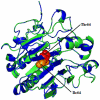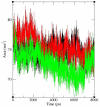Investigating the structural impacts of I64T and P311S mutations in APE1-DNA complex: a molecular dynamics approach
- PMID: 22384055
- PMCID: PMC3288039
- DOI: 10.1371/journal.pone.0031677
Investigating the structural impacts of I64T and P311S mutations in APE1-DNA complex: a molecular dynamics approach
Abstract
Background: Elucidating the molecular dynamic behavior of Protein-DNA complex upon mutation is crucial in current genomics. Molecular dynamics approach reveals the changes on incorporation of variants that dictate the structure and function of Protein-DNA complexes. Deleterious mutations in APE1 protein modify the physicochemical property of amino acids that affect the protein stability and dynamic behavior. Further, these mutations disrupt the binding sites and prohibit the protein to form complexes with its interacting DNA.
Principal findings: In this study, we developed a rapid and cost-effective method to analyze variants in APE1 gene that are associated with disease susceptibility and evaluated their impacts on APE1-DNA complex dynamic behavior. Initially, two different in silico approaches were used to identify deleterious variants in APE1 gene. Deleterious scores that overlap in these approaches were taken in concern and based on it, two nsSNPs with IDs rs61730854 (I64T) and rs1803120 (P311S) were taken further for structural analysis.
Significance: Different parameters such as RMSD, RMSF, salt bridge, H-bonds and SASA applied in Molecular dynamic study reveals that predicted deleterious variants I64T and P311S alters the structure as well as affect the stability of APE1-DNA interacting functions. This study addresses such new methods for validating functional polymorphisms of human APE1 which is critically involved in causing deficit in repair capacity, which in turn leads to genetic instability and carcinogenesis.
Conflict of interest statement
Figures









Similar articles
-
Modulation of the Apurinic/Apyrimidinic Endonuclease Activity of Human APE1 and of Its Natural Polymorphic Variants by Base Excision Repair Proteins.Int J Mol Sci. 2020 Sep 28;21(19):7147. doi: 10.3390/ijms21197147. Int J Mol Sci. 2020. PMID: 32998246 Free PMC article.
-
The impact of single-nucleotide polymorphisms of human apurinic/apyrimidinic endonuclease 1 on specific DNA binding and catalysis.Biochimie. 2019 Aug;163:73-83. doi: 10.1016/j.biochi.2019.05.015. Epub 2019 May 28. Biochimie. 2019. PMID: 31150756
-
Molecular and structural characterization of disease-associated APE1 polymorphisms.DNA Repair (Amst). 2020 Jul-Aug;91-92:102867. doi: 10.1016/j.dnarep.2020.102867. Epub 2020 May 16. DNA Repair (Amst). 2020. PMID: 32454397 Free PMC article.
-
Molecular Mechanisms Regulating the DNA Repair Protein APE1: A Focus on Its Flexible N-Terminal Tail Domain.Int J Mol Sci. 2021 Jun 11;22(12):6308. doi: 10.3390/ijms22126308. Int J Mol Sci. 2021. PMID: 34208390 Free PMC article. Review.
-
Functions of the major abasic endonuclease (APE1) in cell viability and genotoxin resistance.Mutagenesis. 2020 Feb 13;35(1):27-38. doi: 10.1093/mutage/gez046. Mutagenesis. 2020. PMID: 31816044 Free PMC article. Review.
Cited by
-
Structural characterization of single nucleotide variants at ligand binding sites and enzyme active sites of human proteins.Biophys Physicobiol. 2016 Jul 14;13:157-163. doi: 10.2142/biophysico.13.0_157. eCollection 2016. Biophys Physicobiol. 2016. PMID: 27924270 Free PMC article.
-
An In Silico Study Investigating Camptothecin-Analog Interaction with Human Protein Tyrosine Phosphatase, SHP2 (PTPN11).Pharmaceuticals (Basel). 2023 Jun 26;16(7):926. doi: 10.3390/ph16070926. Pharmaceuticals (Basel). 2023. PMID: 37513838 Free PMC article.
-
A Dual Face of APE1 in the Maintenance of Genetic Stability in Monocytes: An Overview of the Current Status and Future Perspectives.Genes (Basel). 2020 Jun 11;11(6):643. doi: 10.3390/genes11060643. Genes (Basel). 2020. PMID: 32545201 Free PMC article. Review.
-
Structural and physico-chemical effects of disease and non-disease nsSNPs on proteins.Curr Opin Struct Biol. 2015 Jun;32:18-24. doi: 10.1016/j.sbi.2015.01.003. Epub 2015 Feb 4. Curr Opin Struct Biol. 2015. PMID: 25658850 Free PMC article. Review.
-
A novel causative functional mutation in GATA6 gene is responsible for familial dilated cardiomyopathy as supported by in silico functional analysis.Sci Rep. 2022 Aug 12;12(1):13752. doi: 10.1038/s41598-022-13993-6. Sci Rep. 2022. PMID: 35962153 Free PMC article.
References
-
- Mol CD, Izumi T, Mitra S, Tainer JA. DNA-bound structures and mutants reveal abasic DNA binding by APE1 and DNA repair coordination. Nature. 2000;403:451–456. - PubMed
-
- Wilson DM, III, Bohr VA. The Mechanics of base excision repair and its relationship to aging and disease. DNA Repair (Amst.) 2007;6:544–559. - PubMed
-
- Yu E, Gaucher SP, Hadi MZ. Probing conformational changes in Ape1 during the progression of base excision repair. Biochemistry. 2010;49:3786–96. - PubMed
MeSH terms
Substances
LinkOut - more resources
Full Text Sources
Research Materials
Miscellaneous

